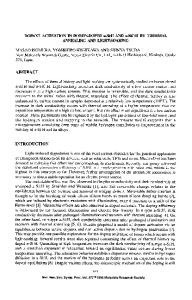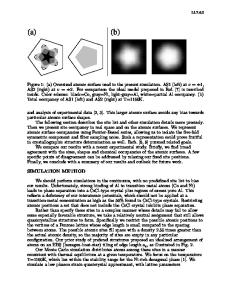A Thermal Equilibrium Model for the Dopant and Defect Structure in a-Si:H
- PDF / 302,937 Bytes
- 6 Pages / 420.48 x 639 pts Page_size
- 20 Downloads / 278 Views
A THERMAL
GERHARD
EQUILIBRIUM MODEL FOR THE DOPANT AND DEFECT STRUCTURE IN
MOLLER,
Messerschmitt-B6lkow-Blohm GmbH, Postfach 80 8000 M~nchen 80, Fed. Rep. of Germany.
11
a-Si:H
09,
ABSTRACT Our previous thermal equilibrium approach, based on the assumption of an intrinsic relaxation mechanism, has been evaluated on a quantitative scale. The predictions of this model are compared to experimental defect density data and a microscopic description of the thermalization process is presented.
INTRODUCTION Recently (1), we have proposed that the a-Si:H lattice is able to support an intrinsic relaxation mechanism that adjudsts the density of dangling bond states near mid-gap to the densities of charge carriers in localized band tail states according to: Si(4/0) + e(-) Si(4/O) + e(+) and:
v- Si(3/-)
(Ia)
Si(3/+)
(Ib)
•
Si(3/+) + Si(3/-)
*
.-
2Si(3/0)
(Ic)
Here, Si(4/0) stands for normally coordinated network atoms, Si(3/+,O,-) for 3-fold coordinated Si-atoms that give rise to dangling bond states near midgap and e(-) and e(+) for charge carriers in localized band-tail states. Supplementing these reactions by the doping reactions P(3/0) and:
B(3/O)
-
PP(4/+) + e(-)
(IIa)
B(4/-) + e(+)
(IIb)
we have shown that a thermal equilibrium formalism can be derived that, in its nature, is a generalization of Street's auto-compensation model of doping (4) and that, in addition, allows doping, compensation and various degradation phenomena to be treated within a single and unifying approach (1). In the present paper we should like to briefly review some of the results that have been obtained from a quantitative elaboration of the formalism (2) and to discuss the kinetics of the thermalizastion process in more detail (3).
EQUILIBRIUM PROPERTIES OF a-Si:H FILMS Assuming that equilibration proceeds through reactions Ia-c, our model predicts a low defect density in those situations in which the electronic occupation of the band tail states is negligible. Specifically, this should
"Mat. Res. Soc. Symp. Proc. Vol. 118. , 1988 Materials Research Society
286
apply to undoped a-Si:H at low temperature. When the carrier density in the doping or alloying band tail states is enhanced by illumination, annealing, with foreign impurities, reactions Ia and b are driven to the right-hand-side inducing an enhanced defect density. Analyzing these situations in more detail (2) we have obtained the results summarized in figs. 1-4. In fig.l, the variation of Nd, the equilibrium density of dangling bonds, is plotted as a function of (Ec-Ef) with the magnitude of the equilibration temperature as a parameter. Also included in this figure are experimental defect density data that have been obtained on differently doped aSi:H material. Comparing both data sets, it is seen that reasonable agreement is obtained provided that the comparison is made at the experimentally determined equilibration temperatures (5) and the appropriate Fermi-energy posithe experimental data are seen to deviate At room temperature, tions (6). more or less m
Data Loading...







